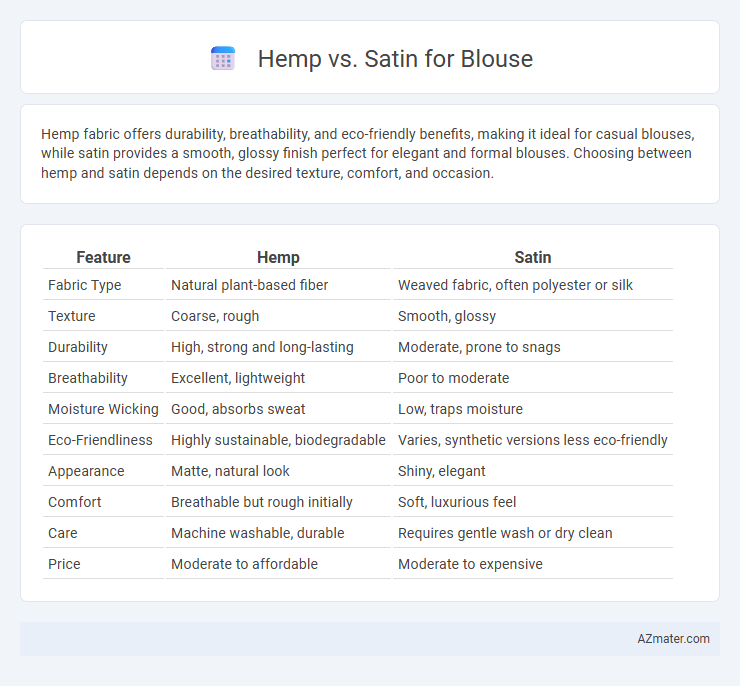Hemp fabric offers durability, breathability, and eco-friendly benefits, making it ideal for casual blouses, while satin provides a smooth, glossy finish perfect for elegant and formal blouses. Choosing between hemp and satin depends on the desired texture, comfort, and occasion.
Table of Comparison
| Feature | Hemp | Satin |
|---|---|---|
| Fabric Type | Natural plant-based fiber | Weaved fabric, often polyester or silk |
| Texture | Coarse, rough | Smooth, glossy |
| Durability | High, strong and long-lasting | Moderate, prone to snags |
| Breathability | Excellent, lightweight | Poor to moderate |
| Moisture Wicking | Good, absorbs sweat | Low, traps moisture |
| Eco-Friendliness | Highly sustainable, biodegradable | Varies, synthetic versions less eco-friendly |
| Appearance | Matte, natural look | Shiny, elegant |
| Comfort | Breathable but rough initially | Soft, luxurious feel |
| Care | Machine washable, durable | Requires gentle wash or dry clean |
| Price | Moderate to affordable | Moderate to expensive |
Introduction to Hemp and Satin Fabrics
Hemp fabric is derived from the fibers of the Cannabis sativa plant, known for its durability, breathability, and eco-friendly properties, making it a sustainable choice for blouses. Satin, typically made from silk, polyester, or nylon, features a smooth, glossy surface achieved through a weaving technique that gives it a luxurious appearance and soft texture. When choosing between hemp and satin for blouses, considerations include hemp's natural moisture-wicking and strength versus satin's elegant sheen and fluid drape.
Origin and Manufacturing Processes
Hemp fabric originates from the fibers of the Cannabis sativa plant, cultivated primarily in North America and China through a sustainable process involving retting and decortication to extract durable bast fibers. Satin, traditionally derived from silk produced by silkworms mainly in China and India, undergoes a weaving technique called satin weave that creates a smooth, glossy surface with a high thread count. Hemp's manufacturing emphasizes eco-friendly practices and biodegradability, whereas satin production focuses on intricate weaving craftsmanship to achieve its characteristic luster and softness.
Texture and Feel Comparison
Hemp fabric offers a coarse, sturdy texture with a natural matte finish, providing a breathable and slightly rough feel ideal for casual, durable blouses. Satin features a smooth, glossy surface created by tightly woven fibers, resulting in a silky, soft touch that enhances elegance and comfort in dressier blouse styles. The contrast in texture between hemp's ruggedness and satin's sleekness directly influences the overall sensory experience and suitability for different fashion needs.
Durability and Longevity
Hemp fabric offers exceptional durability and longevity due to its strong natural fibers, making it resistant to wear and tear over time. Satin, while smooth and luxurious, tends to be more delicate and prone to snags or fraying, which can reduce its lifespan with frequent use. Choosing hemp for a blouse ensures a sturdier garment that maintains its shape and integrity after many washes compared to satin's more fragile nature.
Breathability and Comfort Levels
Hemp fabric offers excellent breathability due to its natural fibers, allowing better air circulation and moisture-wicking properties ideal for warm weather blouses. Satin, typically made from silk or synthetic fibers, provides a smooth and luxurious feel but tends to trap heat and moisture, reducing overall comfort during extended wear. Choosing hemp for a blouse enhances comfort through superior airflow and temperature regulation, while satin prioritizes aesthetic appeal over breathability.
Environmental Impact and Sustainability
Hemp fabric for blouses offers superior environmental benefits due to its rapid growth cycle, low water consumption, and natural resistance to pests, requiring minimal pesticides or fertilizers. Satin, often derived from synthetic fibers or chemically processed silk, typically involves higher energy use and pollution during production, making it less sustainable. Choosing hemp supports biodegradable, eco-friendly fashion while reducing the garment's carbon footprint compared to satin alternatives.
Style and Visual Appeal
Hemp blouses offer a natural, matte texture with an organic, rustic aesthetic that appeals to eco-conscious fashion enthusiasts. Satin blouses deliver a smooth, glossy finish that enhances elegance and sophistication, ideal for formal or evening wear. The choice between hemp and satin significantly impacts the garment's visual appeal, with hemp emphasizing earthy, casual style and satin projecting luxury and refinement.
Care and Maintenance
Hemp blouses require minimal care with natural resistance to wrinkles, but should be hand-washed or machine-washed in cold water to preserve fabric strength and avoid shrinkage. Satin blouses demand delicate handling, often requiring dry cleaning or gentle hand washing with mild detergent to maintain their smooth, glossy finish and prevent snagging. Proper storage away from direct sunlight and using padded hangers for both fabrics extends their longevity and appearance.
Cost and Accessibility
Hemp fabric for blouses offers a cost-effective and eco-friendly alternative, with prices generally lower due to its sustainable cultivation and durability. Satin, often made from silk or synthetic fibers, tends to be more expensive and less accessible because of its luxurious texture and production complexity. Accessibility for hemp remains higher in eco-conscious markets, whereas satin is widely available in mainstream fashion stores but at a premium price.
Choosing the Right Fabric for Your Blouse
Hemp fabric offers durability, breathability, and eco-friendly benefits, making it ideal for casual, sustainable blouses that prioritize comfort and longevity. Satin provides a smooth, glossy finish with a luxurious appearance, perfect for elegant or evening wear that demands a refined texture and sheen. Choosing the right fabric depends on your desired blouse function: opt for hemp for natural, robust daily wear and satin for sophisticated, stylish occasions.

Infographic: Hemp vs Satin for Blouse
 azmater.com
azmater.com